

Ruby - Semantic Web Standards. RDF in Ruby revisited. If you’re interested in collaborating on Ruby tools for RDF, please join the public-rdf-ruby@w3.org mailing list at W3C.
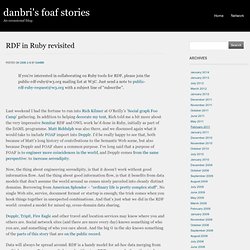
Just send a note to public-rdf-ruby-request@w3.org with a subject line of “subscribe”. Last weekend I had the fortune to run into Rich Kilmer at O’Reilly’s ‘Social graph Foo Camp‘ gathering. In addition to helping decorate my tent, Rich told me a bit more about the very impressive Semitar RDF and OWL work he’d done in Ruby, initially as part of the DAML programme. Matt Biddulph was also there, and we discussed again what it would take to include FOAF import into Dopplr. I’d be really happy to see that, both because of Matt’s long history of contributions to the Semantic Web scene, but also because Dopplr and FOAF share a common purpose. Now, the thing about engineering serendipity, is that it doesn’t work without good information flow. Dopplr, Tripit, Fire Eagle and other travel and location services may know where you and others are.
A Rubyist's instant grasp on semantic web. The state of Ruby, RDF and Rails 3. Edit Posted by Eric Kidd on 12/20/2010 Recently, I was investigating the state of RDF in the Ruby world.

Here are some notes, in case anybody is curious. I have used only a few of these Ruby RDF libraries, so please feel free to add your own comments with corrections and other alternatives. There’s also some stuff about ActiveModel and ActiveRelation down at the end, for people who are interested in Rails 3. Extending Ruby on Rails for Semantic Web Applications - TechWeb Digital Library. Obie Fernandez : Ruby on Rails and more... Tuesday June 14, 2005 Sorry everyone for not blogging as much lately. It's just I've been having more fun with Ruby and Semantic Web stuff than anyone should legally be allowed to have. Today I made a conceptual breakthrough which is too exciting not to share right away.
So, here is my teaser challenge: Can you figure out what the following code does and why I believe it is a significant development? Right now I'm fleshing out the code and also making it a module instead of a Class. Why is this cool? A much better explanation of the concepts behind this snippet is forthcoming tonight, I promise! (Posted at Jun 14 2005, 10:57:26 PM EDT by Obie) Permalink Tagged: Comments are screened and may take up to 24 hours to be approved.
Getting started with rdflib — rdflib v3.0.0 documentation. Create an Rdflib Graph You might parse some files into a new graph (Introduction to parsing RDF into rdflib graphs) or open an on-disk rdflib store. from rdflib.graph import Graphg = Graph()g.parse(" LiveJournal produces FOAF data for their users, but they seem to use foaf:member_name for a person’s full name.
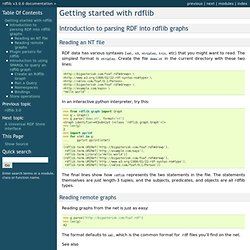
Ruby_on_rails. Bendiken/rdf - GitHub. SPARQL for the Ruby Developer. What?
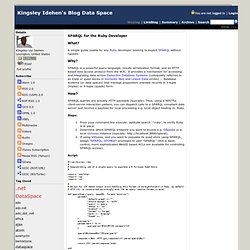
A simple guide usable by any Ruby developer seeking to exploit SPARQL without hassles. Why? SPARQL is a powerful query language, results serialization format, and an HTTP based data access protocol from the W3C. It provides a mechanism for accessing and integrating data across Deductive Database Systems (colloquially referred to as triple or quad stores in Semantic Web and Linked Data circles) -- database systems (or data spaces) that manage proposition oriented records in 3-tuple (triples) or 4-tuple (quads) form.
How? SPARQL queries are actually HTTP payloads (typically). Steps: From your command line execute: aptitude search '^ruby', to verify Ruby is in place Determine which SPARQL endpoint you want to access e.g. RDF.rb: Linked Data for Ruby. 10 Ruby on Rails Best Practices. If you’re new to Ruby on Rails, one of the most daunting aspects is knowing what’s the preferred way of accomplishing a given task.

While a lot of techniques and libraries have come and gone as the community’s preferred way of doing something, there are some best practices that remain, and can lead to writing the cleanest, most secure and maintainable Rails code possible. Listed here today are ten of the most popular and useful best practices you can use as a Ruby developer. Fat Model, Skinny Controller Arguably one of the most important ways to write clear and concise code in Ruby on Rails, the motto “Fat Model, Skinny Controller” refers to how the M and C parts of MVC ideally work together. Namely, any non-response-related logic should go in the model, ideally in a nice, testable method. Let’s look at a simple example. You can change it to this: Then, you can move the logic to your post model, where it might look like this: Getting Started with RDF and SPARQL Using 4store and RDF.rb.
Updated to include some of Arto Bendicken’s recommendations.
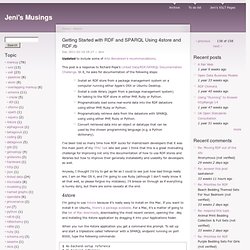
Getting data from the Semantic Web (Ruby) This tutorial is for programmers used to building software on top of non-Semantic-Web data sources: using screen scraping techniques, or using APIs that return XML, JSON, CSV etc.
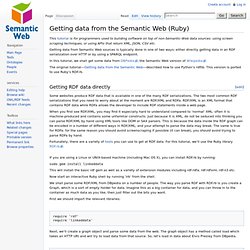
Getting data from Semantic Web sources is typically done in one of two ways: either directly getting data in an RDF serialization over HTTP or by using a SPARQL endpoint. In this tutorial, we shall get some data from DBPedia, the Semantic Web version of Wikipedia. The original tutorial—Getting data from the Semantic Web—described how to use Python's rdflib. 4store version 1.1.1 - 4store-support.